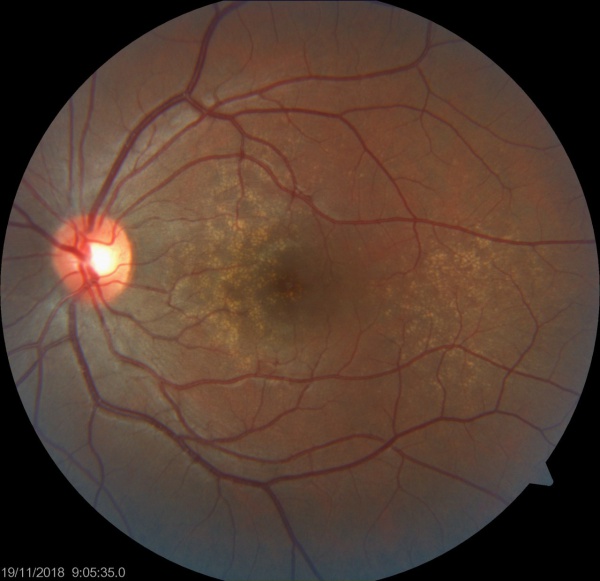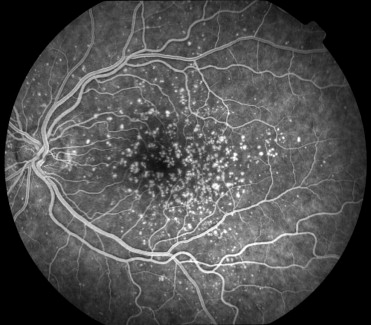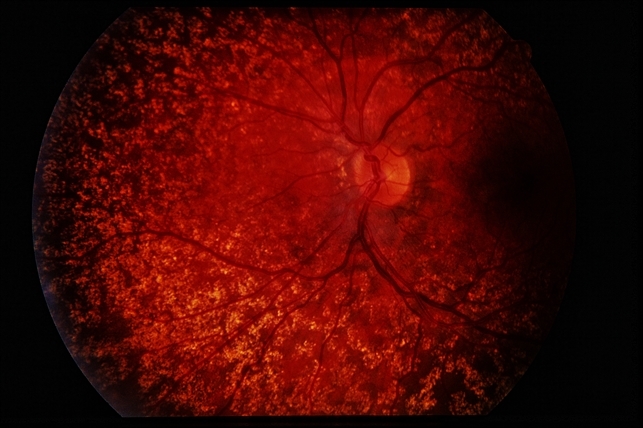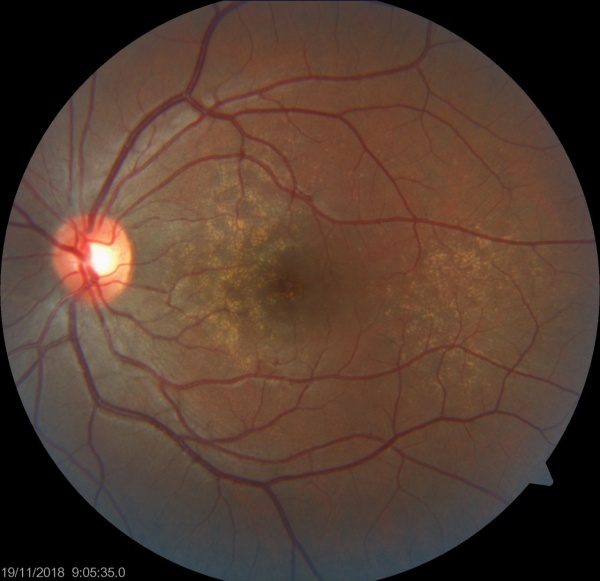CASE REPORT OF BASAL LAMINAR DRUSEN
A 65-year-old woman complained of blurred vision in both eyes. At her first ophthalmic examination, her visual acuity was 20/20 in both eyes. Ophthalmoscopy showed many small sub–RPE deposits in both eyes.

The SD-OCT images showed RPE nodular elevations which had a ‘saw-tooth pattern. This blunted triangular or prolapsed shape has been reported to be typical for cuticular drusen.
Reticular pseudodrusen were also seen in both eyes. The scotopic and photopic full-field electroretinograms were reduced, and Goldmann perimetry showed a decrease in the sensitivity in the pericentral field in both eyes. she was diagnosed with cuticular drusen, and placed on a periodic follow-up examination schedule.
DISEASE “BASAL LAMINAR DRUSEN”
Basal laminar drusen/Cuticular drusen is an uncommon entity. Although originally thought to be distinct from age-related macular degeneration, it is now considered to be in the same spectrum as macular degeneration.
Findings include numerous small yellow drusen on examination, which are more obvious on fundus auto-fluorescence. Fluorescein angiography (FA) demonstrates punctuate areas of early staining throughout the macula, with a “stars in the sky” pattern.
Vitelliform macular lesions development, choroidal neovascularization (CNV), and geographic atrophy (GA) may cause vision loss.

DIAGNOSIS
Basal laminar drusen diagnosis is clinical, based on dilated fundus examination, fundus autofluorescence, and FA.
MANAGEMENT OF BASAL LAMINAR DRUSEN
Patients with basal laminar drusen should be monitored for the development of “pseudovitelliform” retinal pigment epithelium lesions/detachment, CNV, or GA which may be visually significant.
The complete pathophysiology of BLD has not been elucidated and a CFH mutation has been implicated in the development of membranoproliferative glomerulonephritis type 2 (MPGN type II) (dense deposit disease) and atypical hemolytic uremic syndrome (aHUS).
It is recommended that renal function be monitored in those presenting with BLD, especially at an early age (between 5 and 30 years).
In addition,
glomerulonephritis with isolated C3 deposits, a condition that is an intermediate between MPGN and aHUS, also has an association with CFH mutation.

There does not appear to be a correlation between the severity of disease within the kidney and the eye, though 80% of patients with dense deposit disease present with cuticular drusen.
Similarly,
genetic analysis for certain mutations may be beneficial to help guide certain patients with known alleles associated with disease progression.
Would you have interest in taking retina images by smartphone?
Fundus photography is superior to fundus analysis as it enables intraocular pathologies to be photo-captured and encrypted information to be shared with colleagues and patients.
Recent technologies allow smartphone-based attachments and integrated lens adaptors to transform the smartphone into a portable fundus camera and Retinal imaging by smartphone.
RETINAL IMAGING BY YOUR SMARTPHONE
REFERENCES
- 1. Boon, C. J., van de Kar, N. C., Klevering, B. J., Keunen, J. E., Cremers, F. P., Klaver, C. C., Hoyng, C. B., Daha, M. R., & den Hollander, A. I. (2009). The spectrum of phenotypes caused by variants in the CFH gene. Molecular Immunology, 46(8–9), 1573–1594.
- Russell SR, Mullins RF, Schneider BL, Hageman GS. (2000). Location, substructure, and composition of basal laminar drusen compared with drusen associated with aging and age-related macular degeneration. American Journal of Ophthalmology, 129:205-14.
- Grassi MA, Folk JC, Scheetz TE, Taylor CM, Sheffield VC, Stone EM. (2007). Complement factor H polymorphism p.Tyr402His and cuticular Drusen. Arch Ophthalmology, 125:93-7.
- Barbazetto, I. A., Yannuzzi, N. A., Klais, C. M., Merriam, J. E., Zernant, J., Peiretti, E., Yannuzzi, L. A., & Allikmets, R. (2007). Pseudo-Vitelliform Macular Detachment and Cuticular Drusen: Exclusion of 6 Candidate Genes. Ophthalmic Genetics, 28(4), 192–197.
- Balaratnasingam, C, Cherepanoff, S., Dolz-Marco, R., Killingsworth, M.,Chen, F.K., Mendis, R., Mrejen, S. Too, L.K., Gal-Or, O., Curcio, C.A., Freund, K.B., & Yannuzzi, L.A. (2018). Cuticular drusen: Clinical phenotypes and natural history defined using multimodal imaging. Ophthalmology, 125, 100–118.
RETINAL IMAGING BY YOUR SMARTPHONE

RETINAL IMAGING BY YOUR SMARTPHONE


